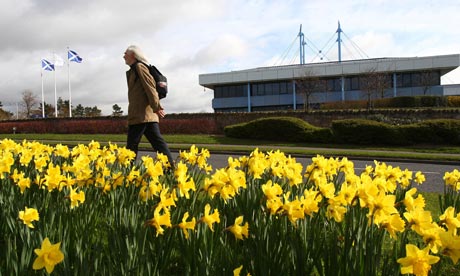Scottish Agenda: Dalziel’s ‘perfect storm’ sank Dunfermline
By Ian Fraser
Published: The Sunday Times
Date: April 5th, 2009

When Lehman Brothers went spectacularly bust on September 14 last year, it sent shockwaves across the global financial markets.
Among other things the investment bank’s collapse caused commercial property valuations to plummet worldwide.
Yet the impact of these cataclysmic events seems to have escaped the notice of Graeme Dalziel, former chief executive of Dunfermline Building Society.
Appearing before the Scottish parliament’s economy, energy and tourism committee, on September 24, 2008, Dalziel told the MSPs: “Our stress-testing shows that we have the capital to withstand and ride out what might be classified as the perfect storm.”
These words are now coming back to haunt the building society’s former boss. The perfect storm ultimately proved far too much for the society to bear and he was forced out of his job last December.
The rot really set in at the society on Dalziel’s watch, when he made a sortie into the commercial property market in 2002. At the same time he launched a disastrously expensive programme to revamp its back-office IT.
Even though the government’s rescue break-up of the society, finalised at lunchtime last Saturday, does seem to have been heavy-handed — the first that chairman Jim Faulds knew of it was when he got a call from a journalist at 2pm that day (by which time the BBC was already running stories that the building society had “collapsed”) it now seems the UK government had little choice other than to break up the society.
The Financial Services Authority had decided it needed a capital injection of at least £60m to survive, and it would never have been able to afford the interest payments.
As of last Monday, the worthwhile bits of the society — mainly its branch network and the depositor base — are in the comparatively safe hands of the Nationwide, the Swindon-based building society which has promised to retain both the branch network and name.
The taxpayer meanwhile has been lumbered with the risk for the “toxic” bits, including the commercial property book. There are parallels to the solution meted out on former building society Bradford & Bingley last October.
The fact that Scotland has now effectively lost its two biggest banks and its largest building society makes one wonder about standards of corporate governance, risk controls and indeed ethics within Scottish financial services.
The sector once had a reputation for prudence but this has been squandered in recent years on the altar of hubristic empire building and the greed by a few rogue bankers. The impression given to the outside world is that, far from being prudent, Scotland’s bankers are in fact reckless in the extreme.
As Lady Bracknell might have said: “to lose two banks may be regarded as a misfortune, but to lose two banks and your largest building society looks like carelessness.”
Walk of shame
Last Friday’s Royal Bank of Scotland annual general meeting was a sombre affair. There was no sign of the self-aggrandising video accompanied by Enya’s track Now We Are Free to which shareholders were formerly subjected.
The chairman Sir Philip Hampton and chief executive Stephen Hester seemed desperate to “draw a line under the past”. Hampton even went so far as to call for the “public flogging” to stop. They’re desperate to reinvent RBS as a normal bank and a responsible corporate citizen.
As a long-term goal, this is something I wholly endorse. However, after the baroque excesses of the Goodwin years — coupled with the problem that some shareholders believe that several of Hampton’s current boardroom colleagues who were there before October last year ought to face criminal investigation — it’s going to be a long hard slog. The humiliation of the bank’s board can only have been exacerbated when 90.4% of shareholders voted against its remuneration report.
Brain drain
The information and communication technologies sector, which employs 100,000 people in Scotland, has provided a rare chink of light amid the doom and gloom that has enveloped Scotland’s economy. A survey out today reveals that 61% of businesses in the sector believe they will increase sales in 2009. The survey, commissioned by ScotlandIS, showed 72% of such companies grew sales last year.
The cloud on the horizon, however, relates to skills and recruitment. Less than half of the firms surveyed expect to increase staffing levels this year (as opposed to 81% last year). This suggests that firms in the sector are more likely to lay off people than to increase headcounts at the moment.
This could be devastating for hundreds of ICT graduates coming out of Scottish universities in coming months. They will almost certainly struggle to land a job in their chosen field, at least in Scotland. Some will move into other sectors; others will look abroad. This will cause a brain drain, storing up a skills shortage for the sector in five or six years’ time.
To view this article on Times Online please click here .
Short URL: https://www.ianfraser.org/?p=802
